Homemade Almond Milk

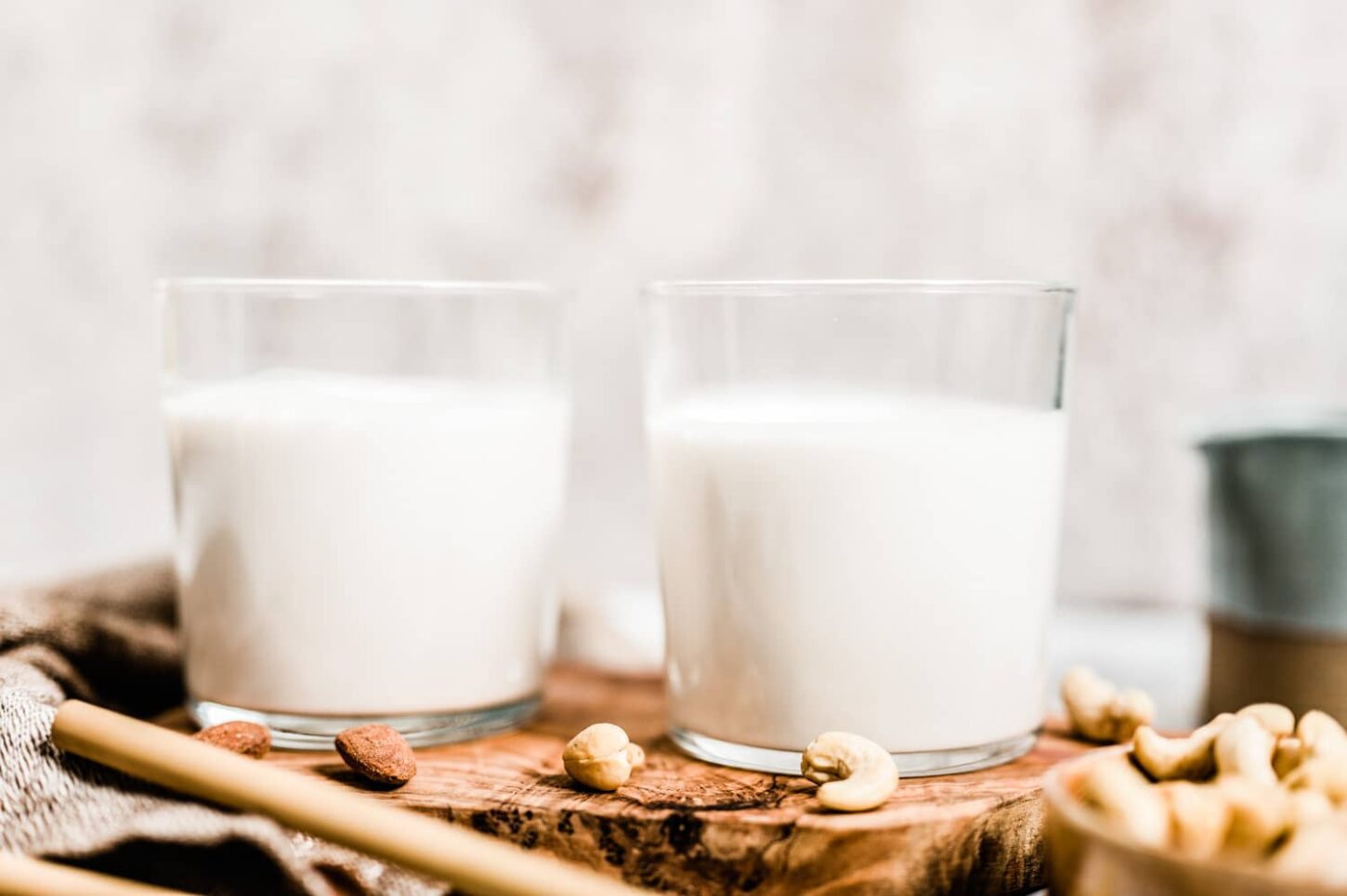
Raise your hand if you’re always running out of almond milk. (Me, me!) If you’re anything like us, you probably go through more plant-based milk than you imagine. That’s why this homemade almond milk recipe is truly a revelation. It’s so much fun to make that you might consider crafting a different, delicious flavor for every day of the week!
Making your own is super simple and quite quick. You just have to remember to soak your almonds overnight—which you can totally do, right? Next day, just blend them with as many cups of water as you like (depending on the consistency that you want). Strain it with a nut milk bag. Maybe add a pinch of sea salt and soft, juicy date before blending. That’s it! Can you believe how easy it is?
If you’re at all intrigued about this almond-y adventure, it’s time to take your milk to the next level!
Table of Contents
- What Are the Benefits of Making My Own Almond Milk?
- How to Make Your Own Almond Milk
- Is a High-Powered Blender Necessary?
- 7 Tips For Making The Tastiest Plant-Based Milk
- Exploring Other Nut Milk Varieties
- Making Almond Milk with a Nut Milk Maker
- How To Serve Up Your Almond Milk Recipe
- Simple Storage
- More Homemade Staple Recipes to Try
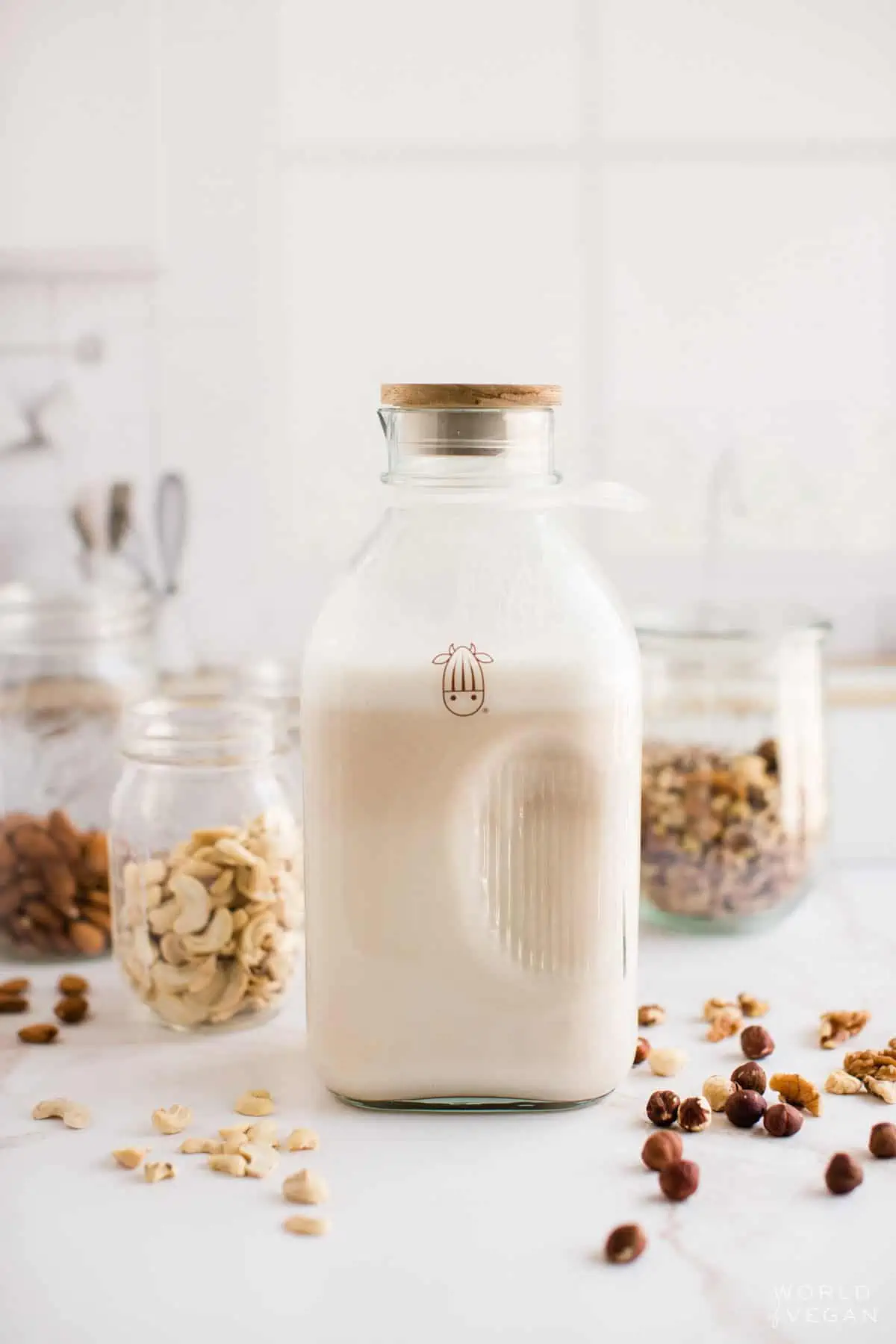
What Are the Benefits of Making My Own Almond Milk?
Making anything by hand is usually time consuming but, in this case, it’s really not. The benefits of making your own plant-based milk truly outweigh the small amount of time that you put into it. If you’re still on the fence about blending up a batch, here are more reasons to surrender to the switch:
- Eco-Friendly – You’ll save the earth from more plastic and plastic-filled containers, not only from the containers that hold the milk, but also from choosing to buy from the bulk bins when you can. Bonus!
- Super Fresh – What could be better than milk made that morning to fill up your breakfast bowl, supplement your smoothie, or tip into your teacup? Pretty much perfect.
- Fantastic Flavor – When you mix up your own milk, you’re free to add whatever sweet or savory additions that you adore. Cinnamon, dates, maple syrup, coconut flakes, extra vanilla, pumpkin spice, cocoa powder, or even other nut combinations. The variety of fabulous flavors is endless!
- Craft Your Own Consistency – By having the amount of water within your control, you can have a luscious liquid with a thinner texture or a sweet, velvety cup of almond cream.
- Pass on the Preservatives – Plant-based milk made from scratch has absolutely no added chemical preservatives, thickeners, or other irritating ingredients that your body does not need. Although your beverage lasts only a few days, you’ll know that it’s completely free of unwanted and unnecessary additives.
How to Make Your Own Almond Milk
You can easily create your own milk using a blender and a nut milk bag.
What you’ll need:
- raw almonds
- Filtered water
- Sweeteners or flavorings (optional, such as dates or vanilla extract)
- High-powered blender
- Nut milk bag or cheesecloth
- Bowl or pitcher for straining
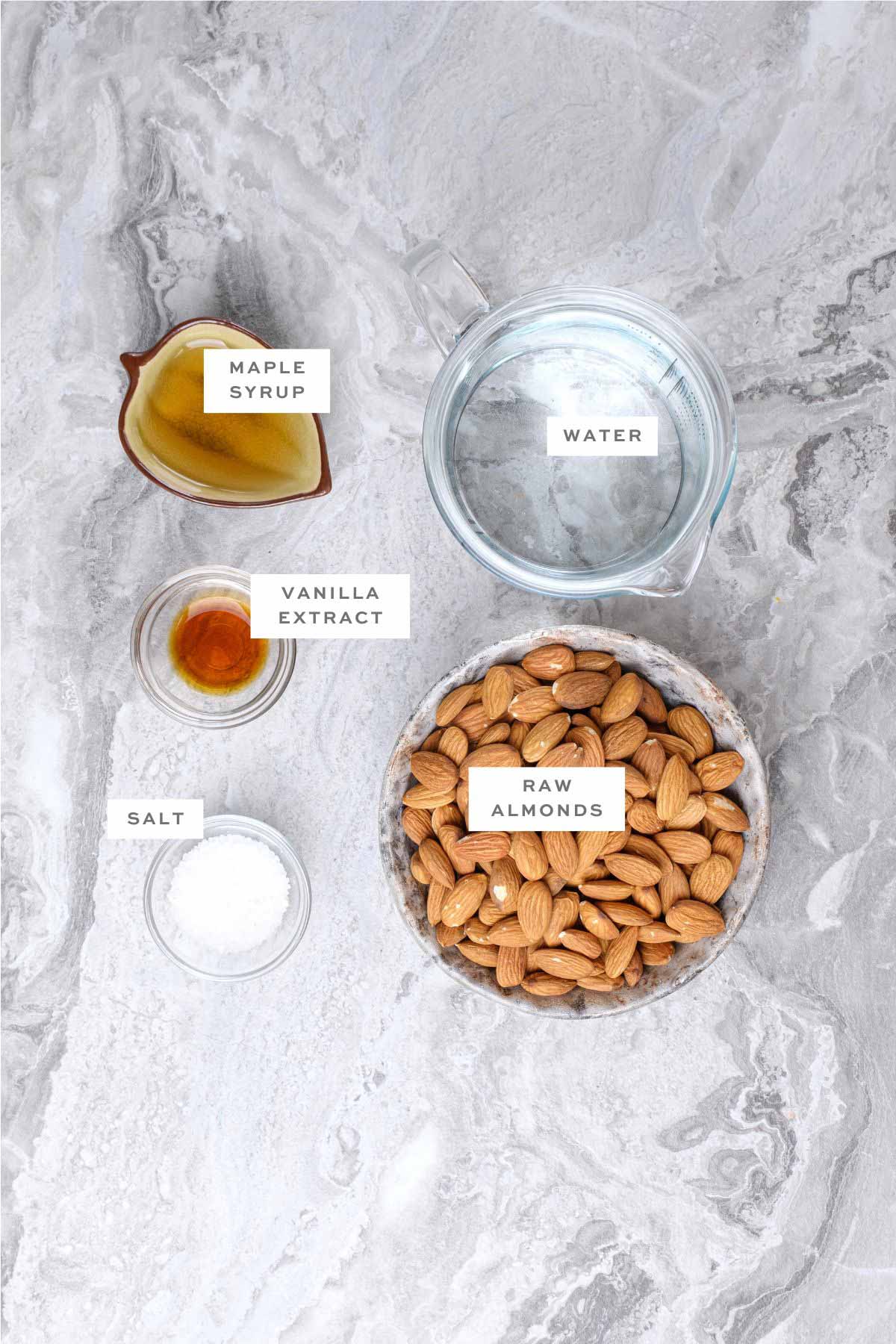
Step-by-Step Process
1. Soak the Almonds: Start by soaking one cup of raw almonds in water overnight or for at least 3 hours. Soaking softens the almonds, making them easier to blend and improving the texture of your almond milk.
2. Rinse and Drain: After soaking, drain and rinse the almonds thoroughly under running water. This helps remove any residual phytic acid and enzyme inhibitors.
3. Blend with Water: Place the soaked almonds in a high-powered blender and add filtered water. For a creamier milk, add less water, and for a thinner milk, add more. If you’d like sweetened almond milk, you can also add sweeteners (such as dates, maple syrup, or sugar) or flavorings (like vanilla extract, strawberries, or cocoa powder).
4. Blend Thoroughly: Blend the mixture on high speed until it becomes creamy and completely smooth. This may take a couple minutes. Using a high-powered blender like a Vitamix is crucial here as it ensures a smoother and more consistent texture. The powerful motor can break down the almonds more effectively, resulting in better almond milk.
5. Strain the Mixture: Place a nut milk bag or cheesecloth over a bowl or pitcher, and carefully pour the blended almond mixture through it. Squeeze and press the bag or cloth to extract as much liquid as possible. This process separates the almond milk from the almond pulp.
6. Store Your Almond Milk: Transfer the strained almond milk to a clean container or bottle. Homemade almond milk can be stored in the refrigerator for up to 3-4 days. Be sure to shake or stir it before using, as it may naturally separate over time.
Your homemade almond milk is now ready to use in coffee, cereal, smoothies, or as a dairy milk substitute in your favorite recipes.
Is a High-Powered Blender Necessary?
Using a high-powered blender, such as a Vitamix or Blendtec, is essential for making almond milk because it offers several advantages:
- Efficient Blending: High-powered blenders can thoroughly break down the almonds, resulting in a smoother and creamier almond milk.
- Quick Process: These blenders have powerful motors that reduce blending time, saving you both time and effort.
- Better Texture: The high speed and strong blades create a finer almond pulp, allowing you to extract more liquid and achieve a silkier texture.
- Versatility: High-powered blenders are versatile kitchen appliances that can handle a wide range of tasks, from blending smoothies to making nut butters and soups.
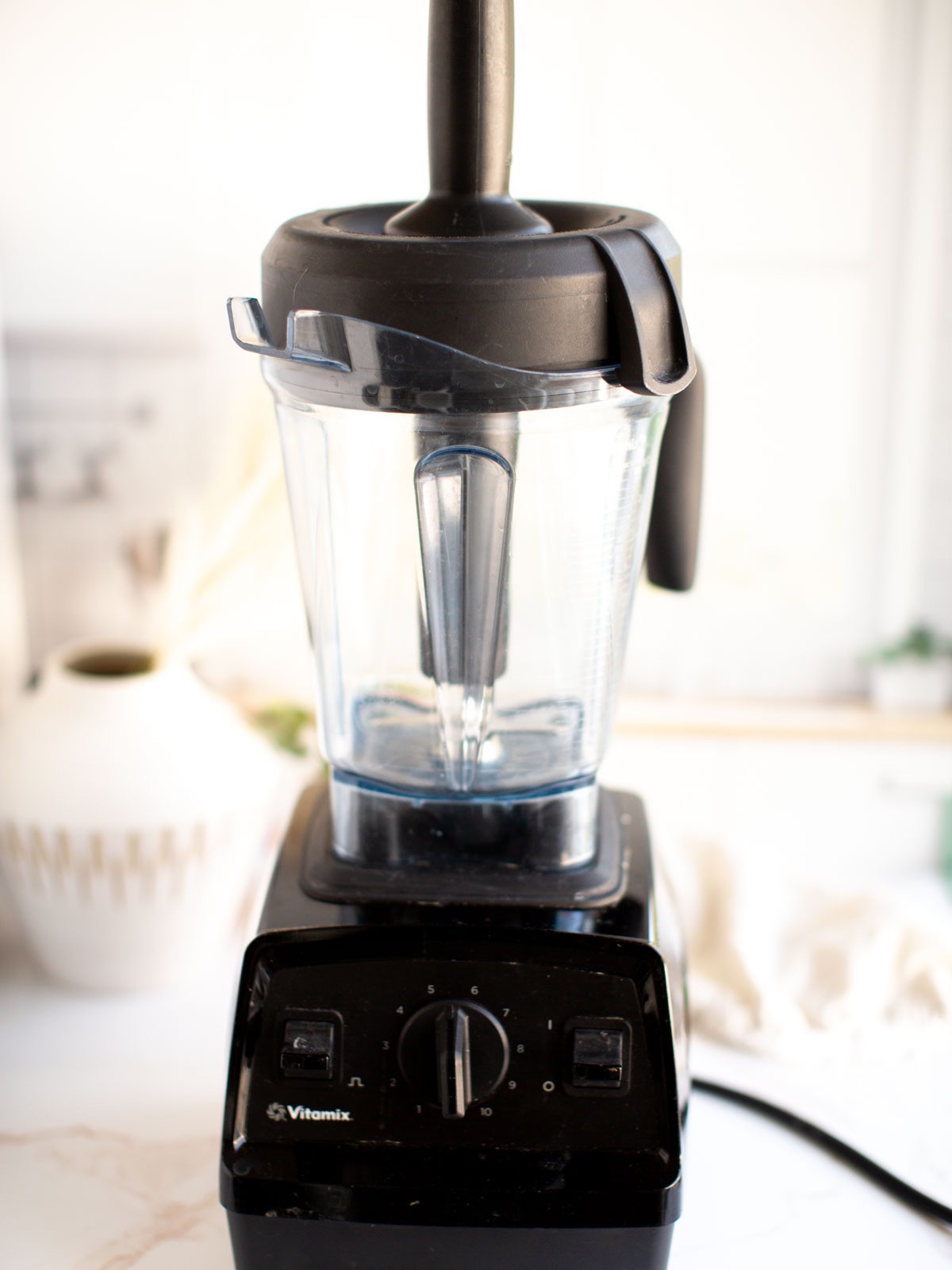
While a high-powered blender is an investment, it’s a valuable tool for those who frequently make homemade nut milk and other blended recipes, offering consistent and superior results.
7 Tips For Making The Tastiest Plant-Based Milk
Almonds are so healthy and should be a part of your daily dozen! Loaded with vitamin E, magnesium, and potassium, these little tear-shaped nuggets are also packed with calcium and phosphorus to help keep your bones healthy and strong. Here are some top tips for blending up the best beverage:
- Almonds are not cheap so keep your eyes open for when they are on sale or buy them in bulk and store in tight glass containers in the fridge or freezer to keep them fresh.
- Try using cold, filtered water for the best taste.
- Store the milk in a bottle with a tight lid so you can give it a shake every time it separates inside the fridge.
- If you’ve got the patience, slip off the skins before blending. (It’s kind of fun!) Doing this creates a much smoother, silkier plant-based milk after blending.
- Experiment with both raw and roasted almonds. Raw almonds are healthier for sure, but roasted almonds have a really lovely flavor when made into milk. Give them both and try and see which one you like better.
- For a thicker texture, try varying the amount of water that you add. Use 3 cups for the lightest liquid, 2 cups for a “half and half” substitute, or a single cup for more of a creamer consistency.
- Wash your hands well before straining the milk. Yes, I know it sounds like a no-brainer, but if you were just cutting up garlic cloves, chopping up chili peppers, or clearing out the compost, you might end up adding extra flavors to your milk that you might not like. Eeek!
Of course, we don’t always have the time to make our own, and we need to have our store-bought favorites at hand. We tasted them and picked the best ones for you, check it out!
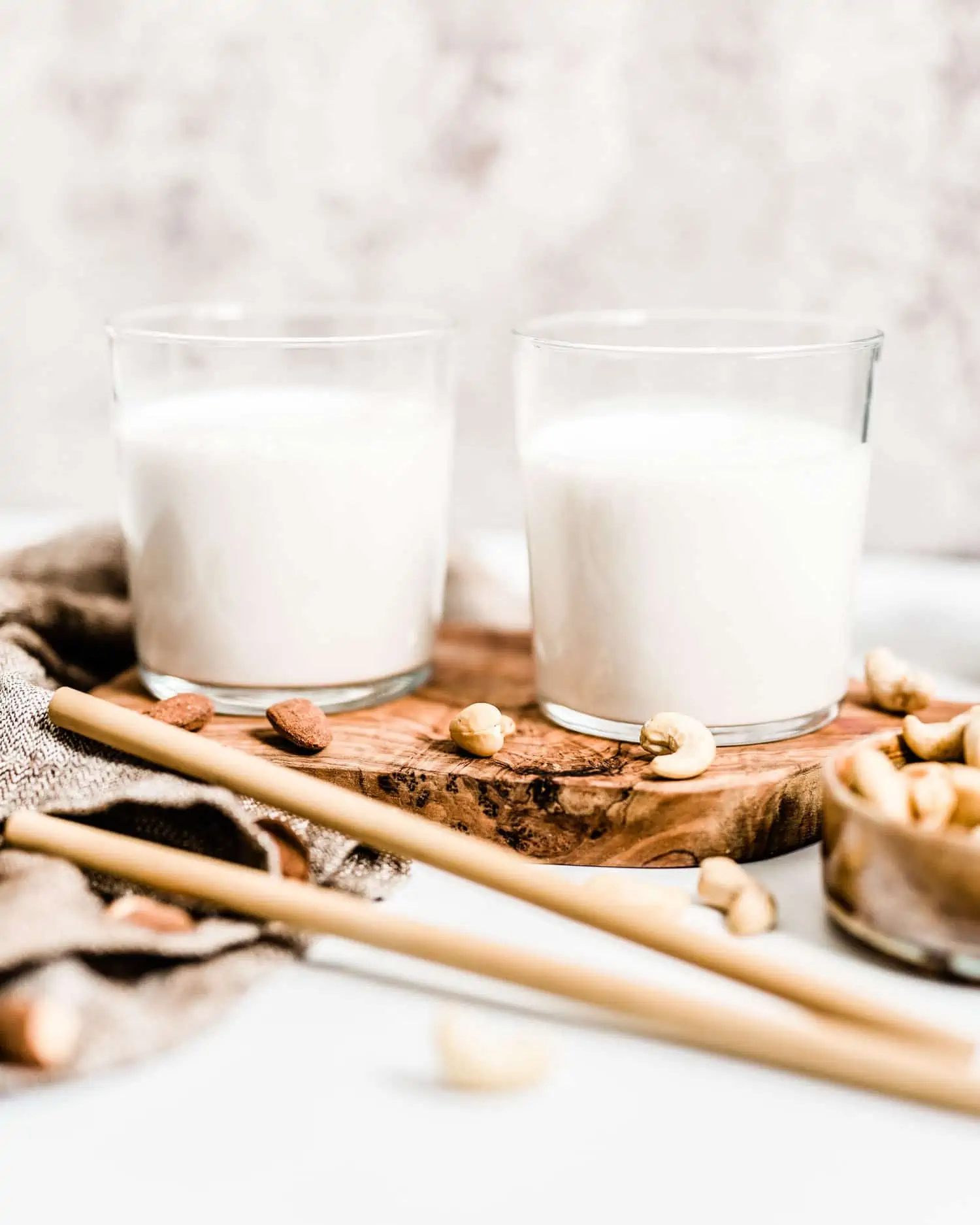
Exploring Other Nut Milk Varieties
Almond milk may be the most popular choice when it comes to plant-based milk alternatives, but it’s just one of many delicious options. All kinds of nuts and seeds can be used to create nutritious and flavorful nut milk, each with its own unique characteristics.
When you’re making your own nut milk at home, you can also mix several nuts together to get a deeper variety of nutritional elements and more complex flavor! Let’s explore a few fantastic nuts that can be blended with water and turned into creamy milk.
Cashews
Cashews are a versatile nut that can yield a creamy and mildly sweet nut milk. They are known for their smooth texture and are an excellent base for a rich and indulgent milk. Cashew milk is naturally lower in fat than almond milk, making it a great choice for those looking to reduce their fat intake.
Hazelnuts
Hazelnuts bring a delightful nutty flavor to the table and create a nut milk with a slightly sweet and earthy taste. Hazelnut milk is often likened to the flavor of hazelnut coffee creamer, making it a fantastic addition to your morning coffee or cereal. It’s also rich in vitamin E and can be a great source of antioxidants.
Walnuts
Walnuts have a distinctive, robust flavor and can produce a nut milk that’s on the heartier side. Walnut milk has a mild bitterness and a creamy texture, making it a unique option for those who appreciate a more intense nutty taste. Plus, walnuts are packed with omega-3 fatty acids, which are great for heart health.
Pecans
Pecan milk offers a slightly sweet and buttery taste that’s perfect for both sweet and savory dishes. It’s a great choice for baking, as it can add a delightful richness to desserts. Pecans are also rich in monounsaturated fats, providing a dose of healthy fats.
Brazil Nuts
Brazil nuts create a nut milk with a distinct flavor and a hint of natural sweetness. They are particularly known for their high selenium content, which can be beneficial for immune support. Brazil nut milk has a unique taste that may take some getting used to, but it can be a great addition to your nut milk repertoire.
Pistachios
Pistachios can produce a nut milk with a delicate and slightly savory taste. It’s a great option for those who prefer a more subtle nut flavor. Pistachio milk is also lower in calories compared to some other nut milks, making it a good choice for calorie-conscious individuals.
Macadamia Nuts
Known for their buttery and creamy texture, macadamia nuts translate beautifully into nut milk. Macadamia milk has a mild and slightly sweet taste that can be enjoyed in a variety of recipes. It’s a luxurious option that’s particularly suitable for lattes and creamy sauces.
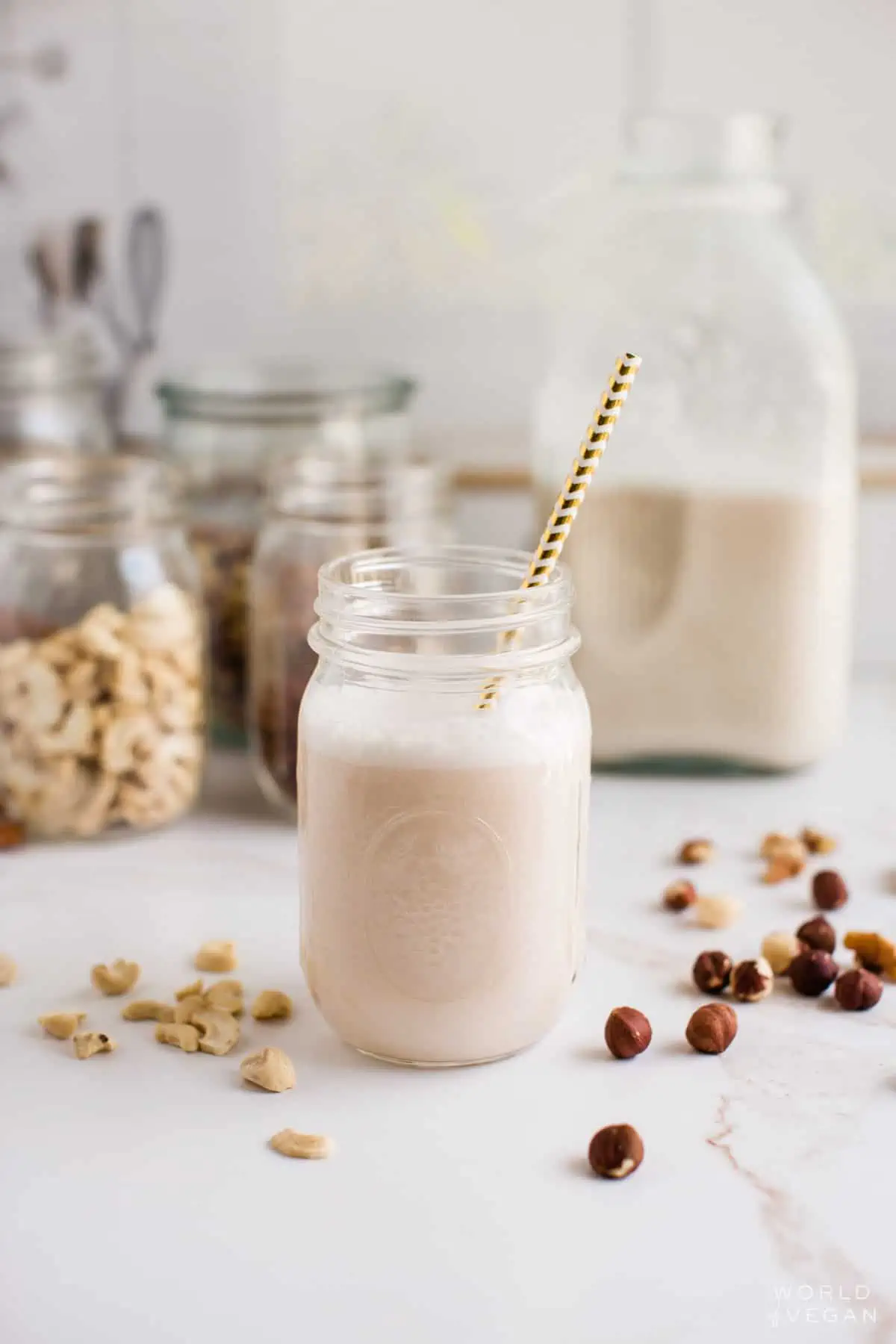
Experimenting with different nuts for homemade nut milk is not only fun but also allows you to tailor your milk to your taste preferences and dietary needs. Whichever nut you choose, you’ll be adding a healthy and dairy-free alternative to your culinary arsenal.
Making Almond Milk with a Nut Milk Maker
Making almond milk at home has gotten even easier, thanks to the convenience of nut milk makers. These innovative kitchen appliances are designed to simplify the process of turning nuts into creamy, delicious nut milk. Simply add water to the basin, add your nuts or seeds and any other additions (sweeteners, extracts, fruit, cocoa powder, etc), and at the touch of a button you’ll have fresh creamy nut milk.
What Do Nut Milk Makers Actually Do?
Nut milk makers are specialized machines that streamline the nut milk-making process. They typically follow these steps:
- Soaking: Many nut milk makers have a built-in soaking feature that allows you to soak your almonds or other nuts for the recommended amount of time to soften them.
- Blending: After soaking, the nuts are blended with water to create a smooth, homogenous mixture. Nut milk makers have powerful blades that ensure thorough blending.
- Straining: The blended mixture is then automatically strained to separate the nut pulp from the liquid. This results in smooth, pulp-free nut milk.
- Heating (Optional): Some nut milk makers also offer a heating function, allowing you to enjoy warm nut milk straight from the machine.
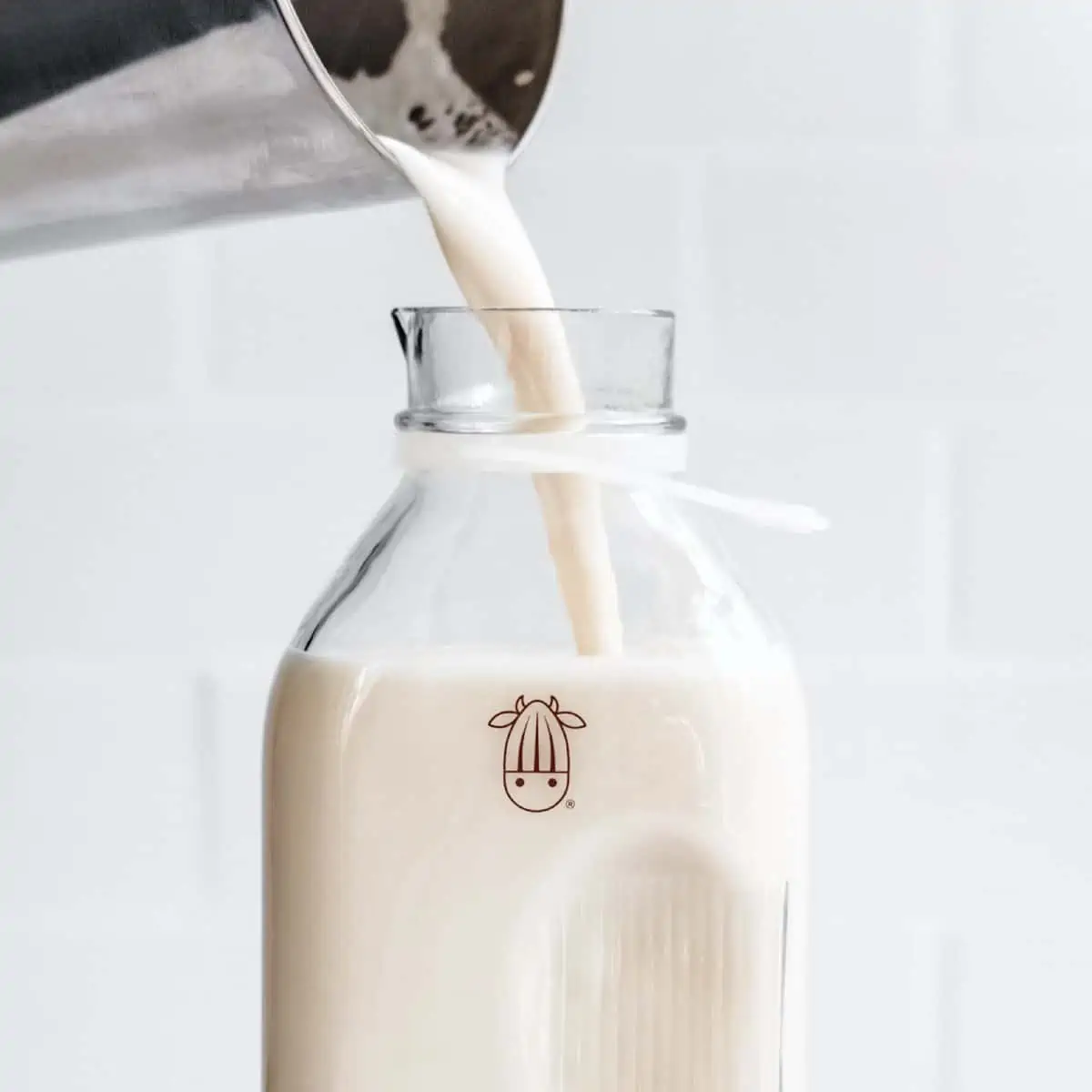
Popular Nut Milk Maker Brands
Almond Cow: Almond Cow is a well-known nut milk maker brand that specializes in almond milk but can also make other nut and seed milks. It offers various settings to customize your milk, and it’s known for its user-friendly design. The Almond Cow is designed to make a full jug of milk with each cycle, so it’s ideal for families who drink milk regularly and are looking for a more eco-friendly option than store-bought milk.
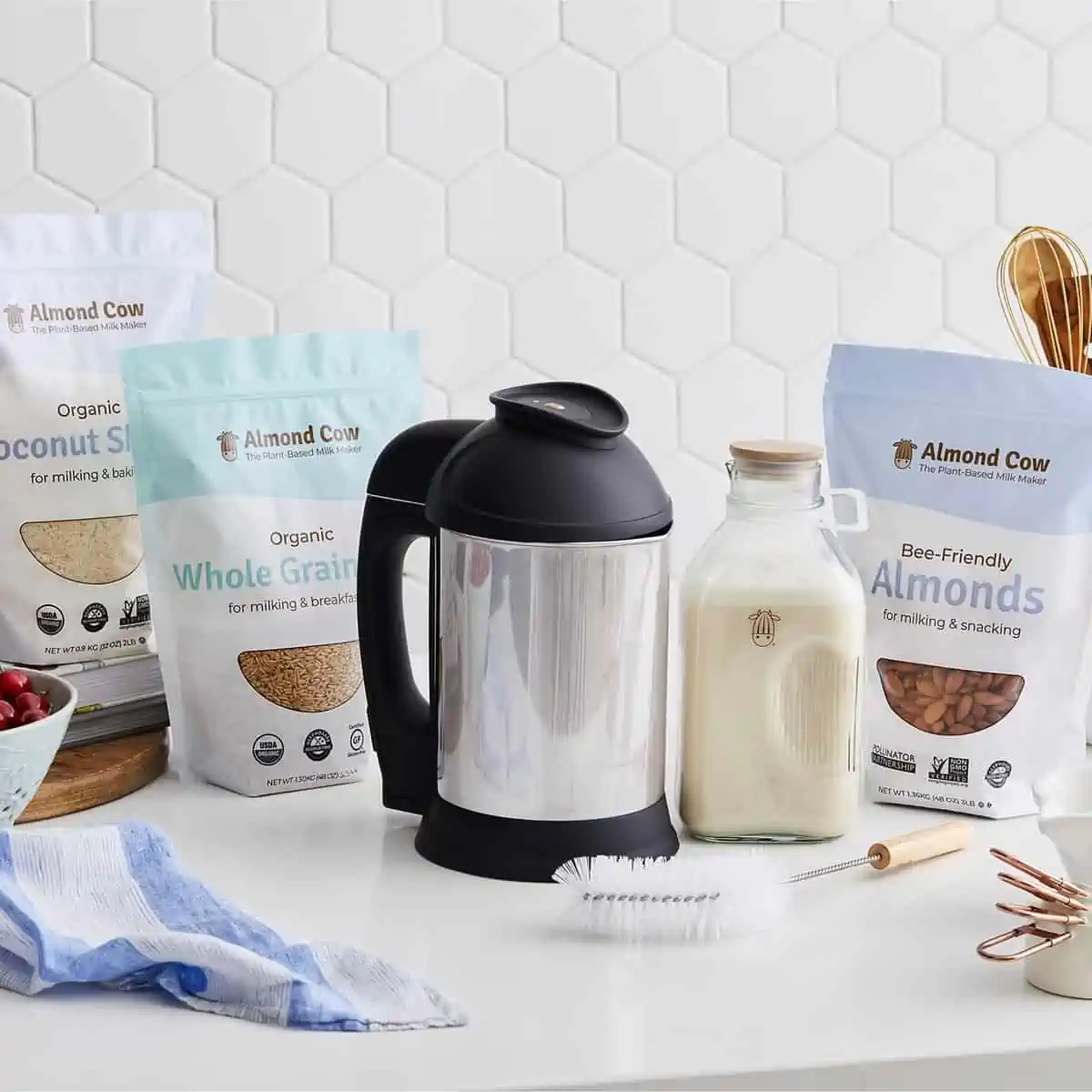
Nutr: This is another popular choice with a versatile approach to nut milk making. It allows you to make a wide range of nut milks, nut butters, and even nut-based flours. It’s appreciated for its convenience and durability.
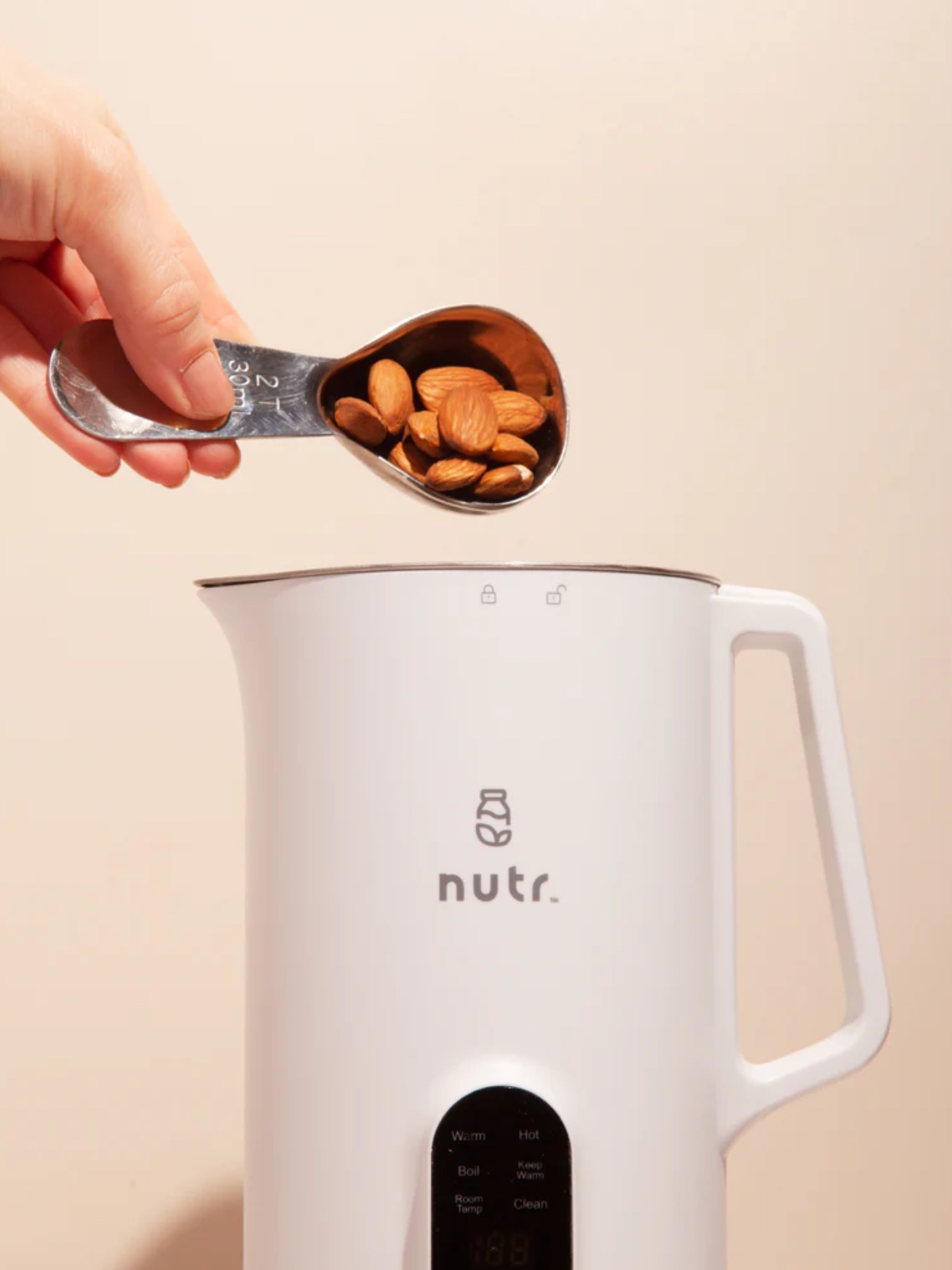
Milky Plant: Milky Plant focuses on simplicity and ease of use. It’s designed to make nut milk quickly and efficiently, perfect for those who want a straightforward approach to homemade nut milk. The milky plant is designed to make a small bottle of milk at a time, so it’s best for individuals who don’t consume a lot of milk, or who want freshly made milk each day.
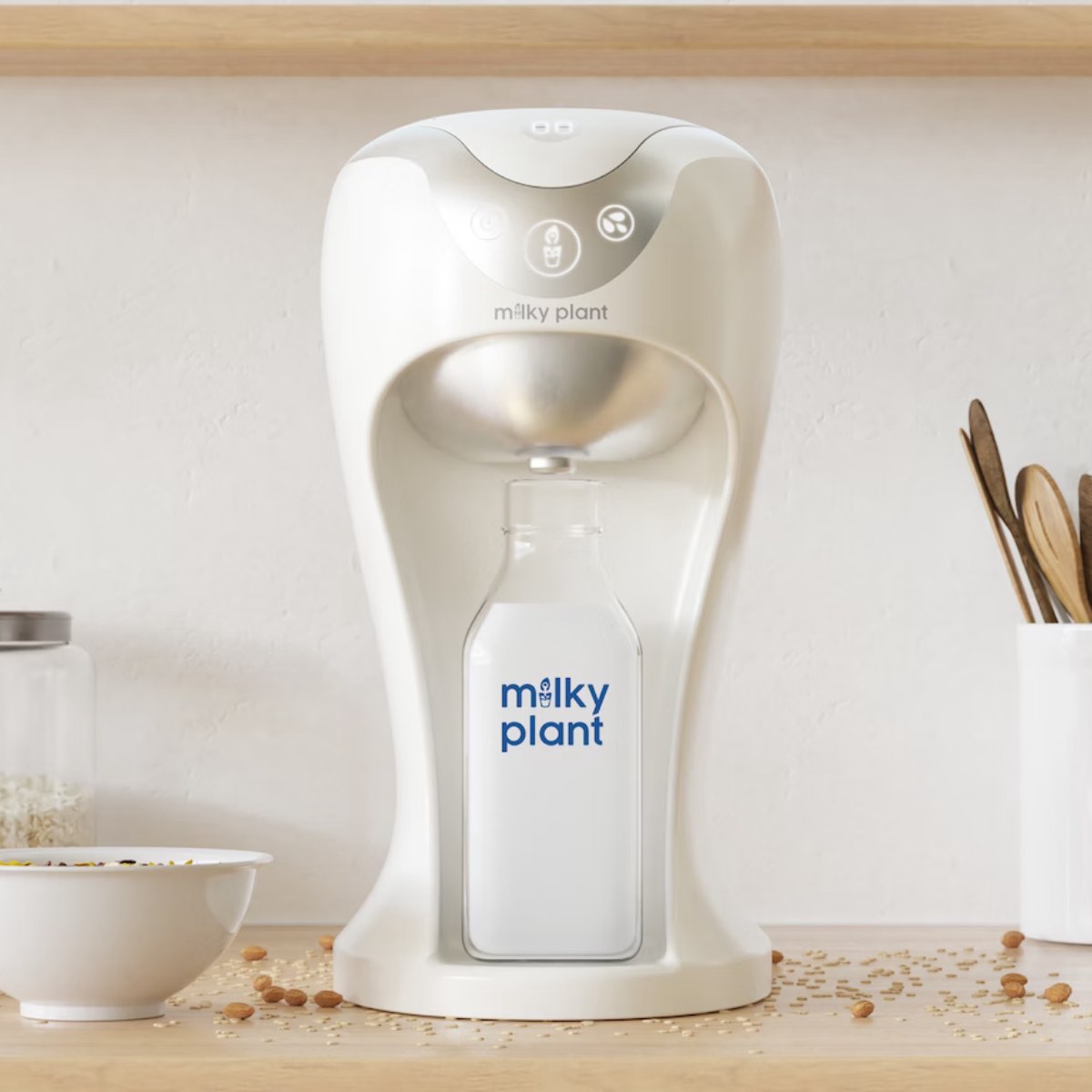
When choosing a nut milk maker, consider factors such as capacity, ease of cleaning, and additional features like heating options or the ability to make nut-based spreads. With a nut milk maker, you can enjoy fresh, preservative-free almond milk and explore other nut and seed milk varieties in the comfort of your own kitchen.
How To Serve Up Your Almond Milk Recipe
So now that you’ve made your fresh and creamy almond milk, what can you do with it? While you could use it to dip yummy cookies into, like these vegan oatmeal cookies or these vegan chocolate cookies, there are hundreds of ways you can use this sweet, nutty beverage! Here are a few of our top favorites:
- Saturate Your Cereal – An oldie, but goodie. The first thing you might think of when it comes to a non-dairy milk is to pour it over your favorite cereal or granola. If you’re a serial cereal lover, you might need to make more than one batch.
- Choose Ch-Ch-Ch-Chia – Every time the word chia is mentioned, don’t you just picture a terra cotta head with sprouts coming out of it? If so, push it out of your mind and replace it with an image of this super thick and rich PB&J Chia pudding. If you switch out the peanut butter for almond butter, you’ll have double the almond awesomeness in every bite!
- Moo-less Smoothies – Let’s leave dairy milk to the darling little calves and whip up our smoothies with almond milk instead. Using almond milk instead of water creates a much creamier consistency with added vitamins, minerals, and healthy fats. So good.
- Love You A Latte – This homemade almond milk recipe is perfect when creating a creamy latte, cozy hot cocoa, or this comforting peppermint mocha. Save yourself some money and make your own delicious, dessert-like hot drink at home.
Simple Storage
This might be one of the few situations in which you’d actually be hoping to have leftovers! Unless you’re overloading your family on overnight oats with almond milk or making several large strawberry smoothies, you’re bound to have a cup or two remaining. Any almond milk that you’d like to save can be stored in a covered glass bottle or mason jar in the fridge for up to 4 days, though the taste is much better when fresh.
If you think you won’t be able to use your leftover almond milk before that time, pour it into an ice cube tray and freeze overnight. Once the cubes are completely frozen, store in freezer bags or sealed containers in the freezer for up to 3 months. Make sure to write the date on the bag or container so you don’t forget. Perfect for throwing into smoothies or adding to iced tea or coffee. Yum!
More Homemade Staple Recipes to Try
- Easy Vegan Butter
- Vegan Condensed Milk
- Oat Milk
- Vegan Nutella Hazelnut Spread
- Easy Almond Flour Crackers
- Vegan Parmesan Sprinkle
- Strawberry Rhubarb Compote
- Coconut Whipped Cream
- Easy Oil Free Hummus
- Pickled Onions & Carrots

Homemade Almond Milk

Ingredients
- 1 cup raw almonds, soaked in water overnight
- 3 cups water
- 2 tablespoons maple syrup, or your favorite sweetener
- 1 teaspoon vanilla extract
- pinch salt
Instructions
- Advance prep: add 1 cup of raw almonds to a bowl, fill with water, and place a cloth on top. Allow the almonds to soak overnight (or for at least 3 hours). Remove the cloth, drain the water, and proceed to the next step.
- In a high-powered blender, add the soaked almonds and 2 cups of water and blend on high until smooth.
- Add the remaining 1 cup of water, maple syrup, vanilla extract, and salt, and blend on high for one minute or until you have a silky smooth milk. There should be no remaining chunks of almond.
- Place your nut milk bag in a large bowl and slowly pour the blended milk into the bag. Using your hands, squeeze the milk through the nut milk bag, allowing the liquid to seep through as the almond pulp remains inside the bag. Continue until only a crumbly clump of almond pulp remains. Set the pulp aside (you won’t be using it for this recipe, but can use it in other recipes or add it to your morning smoothies).
- Pour almond milk into a container (such as a milk jug or mason jars) and store in the fridge until you’re ready to enjoy. Shake well before using and use within 5 days.
Video
Notes
Nutrition
If you’ve finally been convinced that making your own Homemade Almond Milk is the way to go, make sure to let us know what you think by leaving a comment and rating below! We’d love to hear about your favorite vegan almond milk adventures or plant-based milk memories. Be sure to follow along on Pinterest, Instagram and Fa

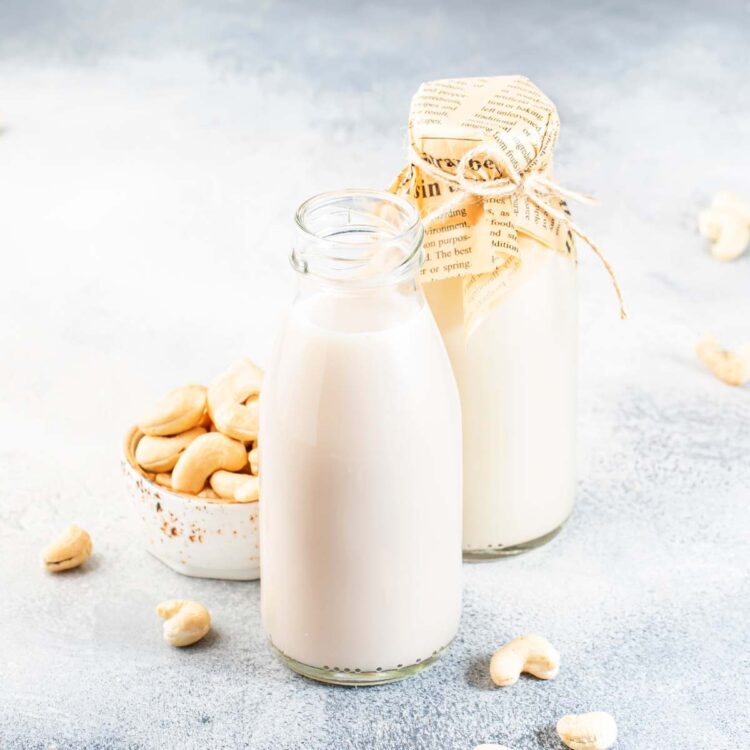
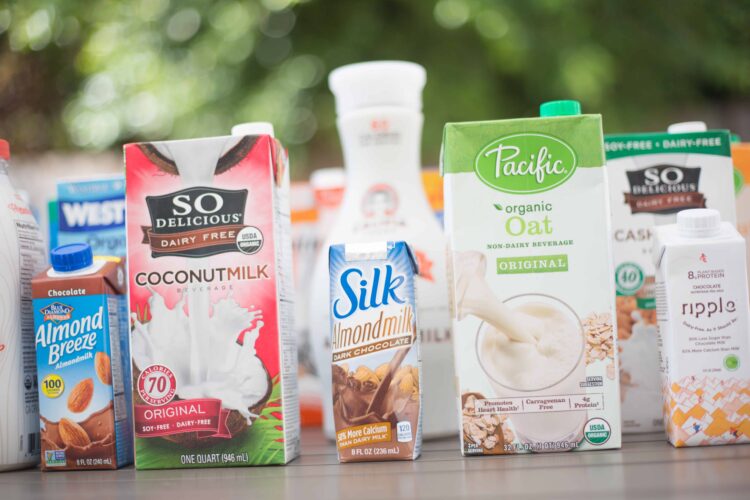

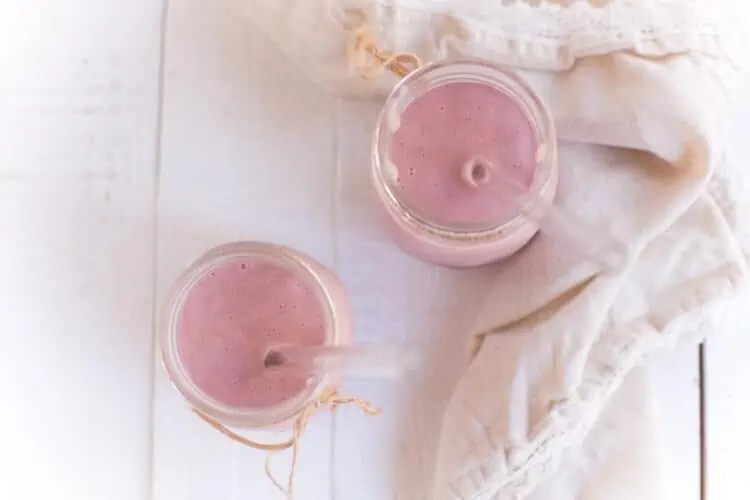

Leave a Comment
Its so easy to make homemade recipes and fun too!
So simple and refreshing!
Love this almond milk recipe! I can’t believe it’s so simple and easy to make your own plant milk – yay!
I’ve been wanting to make my own! Thanks for this easy recipe!!
Homemade almond milk is so delicious. Its easy and fun to make and always impresses people that you’ve made your own!!!
This is such a fun, easy, and tasty recipe! Yay for homemade almond milk 🙂
Oh how I love making my own almond milk! I recently got an Almond Cow which makes it even easier 🙂